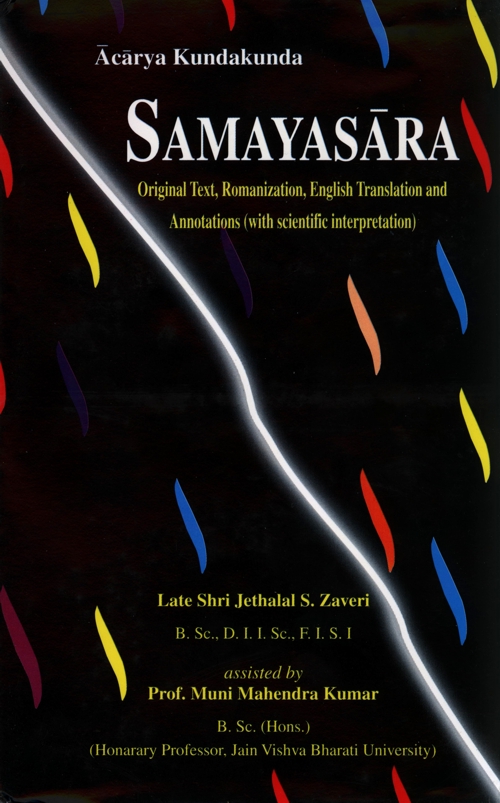
kammaṃ baddhamabaddhaṃ jῑve edaṃ tu jāṇa ṇayapakkhaṃ.
ṇaypakkhātikkaṃto bhaṇṇadi jo so samayasāro..74

doṇha vi ṇayāṇa bhaṇidaṃ jāṇadi ṇavariṃ tu samayapaḍibaddho.
ṇa du ṇayapakkhaṃ giṇhadi kiṃci vi ṇayapakkhaparihῑṇo.. 75

sammaddaṃsaṇaṇāṇaṃ eso lahadi tti ṇavari vavadesaṃ.
savvaṇayapakkharahido bhaṇido jo so samayasāro..76
(Jive kammaṃ baddhamabaddhaṃ edaṃ tu ṇayapakkhaṃ jāṇa) know that discussion regarding the bondage of soul is a fit subject for the doctrine of multiple aspects; (jo ṇayapakkhatikkaṃto bhanṇṇadi so samayasāro) but what transcends all the dialectic of aspects [conflicts and controversies] is called samayasāra the essence of perfect consciousness.
(Doṇha vi ṇayāṇa bhaṇidaṃ ṇavarim tu jāṇadi) He [who has digested the entire scriptural knowledge] is fully aware of both the aspects (samayapadibaddho) but being fully engrossed in the self-experience (ṇayapakkhaparihῑṇo) and having transcended all conflicts of aspects (ṇayapakkhaṃ du kiṃci vi ṇa giṇhadi) remains totally unaffected by the conflicting views [direct apprehension of SELF is free from all dialectical conflicts].
(Jo savvaṇayapakkharahido bhaṇido) He, who is said to have transcended all dialectics of aspects and conflicts (so samayasāro) is the pefect one (eso ṇavari sammaddaṃsaṇaṇāṇaṃ tti vavadesaṃ lahadi) he, the perfect one, alone, is qualified to the title of right belief and right knowledge [samayasāra is synonymous with right faith and right cognition].
Annotations:
In these last verses of the chapter, the author concludes the long discussion of psycho-physical relationship by defining the essence of pure consciousness which is the title term of the book (samayasāra).
The problem of psycho-physical relations is a complex one and has been rendered even more complex by there being two bodies-a gross physical body and a subtle kārmaṇa body. It has given rise to grave misconceptions for want of correct insight and inadequate apprehension of the whole truth. The problem may, in some ways, be compared a or work of art with an intricate internal structure, for instance a musical composition or a sophisticated painting presented to an artistically uncultivated man. In the beginning it has not much significance or meaning to him. But, if his education in the perception of artistic forms proceeds each subordinate part acquires meaning and significance. To the fully trained perception the meaning of the composition, its structure as an artistic whole, are directly apprehended; same is the case with understanding the problem of psycho-physical relations.
We are incapable of a completely adequate apprehension of the whole reality. Our experience and intellectual constructions by which we seek to interpret it have always the character of being piecemeal and fragmentary. By perfect apprehension of the truth as a whole, every fact would be directly seen as linked with every other by the directly intuited nature of the system to which all facts belong. But in imperfect apprehension facts appear to be given in isolation as bare "causal" "conjunctions" or "collocations" and the hypotheses by which we seek to weld them into a system, never quite get rid of an element of arbitrary "free" construction. Hence we can never be sure that our hypothetical constructions are true in a pure or completed experience, at once all-comprehending and systematic (as that of an omniscient) existence and content, fact and construction, are no longer separated and so there could be no place for ultimately uninterpretable data. Such a pure, all-comprehending experience is ‘samayasāra’ 'Perfect consciousness'.
(Idi tidiyo kattikammādhiyāro samatto)
[Here ends the third chapter on Cause & Effect.]
 Jethalal S. Zaveri
Jethalal S. Zaveri
 Prof. Muni Mahendra Kumar
Prof. Muni Mahendra Kumar

